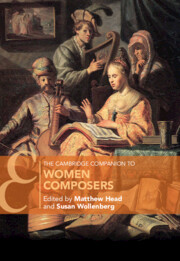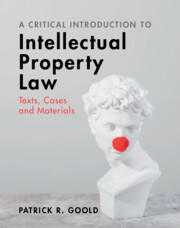123 results
4 - HLVC Methods and Tools
-
- Book:
- Heritage Languages
- Print publication:
- 27 June 2024, pp 37-91
-
- Chapter
- Export citation

The Cambridge Companion to Women Composers
-
- Published online:
- 23 May 2024
- Print publication:
- 30 May 2024

A Critical Introduction to Intellectual Property Law
- Texts, Cases and Materials
-
- Published online:
- 17 May 2024
- Print publication:
- 06 June 2024
-
- Textbook
- Export citation
Promises and perils of positionality statements
-
- Journal:
- Annual Review of Applied Linguistics , First View
- Published online by Cambridge University Press:
- 12 April 2024, pp. 1-8
-
- Article
-
- You have access
- Open access
- HTML
- Export citation
2 - Computable Law and AI
-
-
- Book:
- The Cambridge Handbook of Private Law and Artificial Intelligence
- Published online:
- 21 March 2024
- Print publication:
- 28 March 2024, pp 36-68
-
- Chapter
- Export citation
Chapter 3 - Clarification and Analysis in the Tractatus
-
-
- Book:
- Wittgenstein's <I>Tractatus Logico-Philosophicus</I>
- Published online:
- 07 March 2024
- Print publication:
- 14 March 2024, pp 50-68
-
- Chapter
- Export citation
Chapter 8 - Quantitative EEG (EEG Trend Analysis)
- from Part I - Introduction
-
- Book:
- Critical Care EEG Basics
- Published online:
- 22 February 2024
- Print publication:
- 29 February 2024, pp 109-122
-
- Chapter
- Export citation
7 - Analysis, Performance, and the Deep Nineteenth Century
-
-
- Book:
- The Lied at the Crossroads of Performance and Musicology
- Published online:
- 09 February 2024
- Print publication:
- 15 February 2024, pp 147-170
-
- Chapter
- Export citation
15 - Health Policy
- from Part 2 - Contexts for Public Health Practice
-
-
- Book:
- Essential Public Health
- Published online:
- 01 December 2023
- Print publication:
- 14 December 2023, pp 290-302
-
- Chapter
- Export citation
3 - Analysis (1): The First Movement
-
- Book:
- Robert Schumann: Piano Concerto
- Published online:
- 30 November 2023
- Print publication:
- 30 November 2023, pp 83-114
-
- Chapter
- Export citation
4 - Analysis (2): The Slow Movement and Rondo Finale
-
- Book:
- Robert Schumann: Piano Concerto
- Published online:
- 30 November 2023
- Print publication:
- 30 November 2023, pp 115-145
-
- Chapter
- Export citation
Introduction: When Writing Means Correct Writing
-
- Book:
- You Can't Write That
- Published online:
- 09 November 2023
- Print publication:
- 23 November 2023, pp 1-11
-
- Chapter
-
- You have access
- Open access
- HTML
- Export citation
Chapter 5 - Narrative Methods
-
- Book:
- Applied Narrative Psychology
- Published online:
- 02 November 2023
- Print publication:
- 16 November 2023, pp 63-72
-
- Chapter
- Export citation
2 - Complex Adaptive Systems
- from Part I - Systems, Relations, Levels, and Explanations
-
- Book:
- Systems, Relations, and the Structures of International Societies
- Published online:
- 19 October 2023
- Print publication:
- 02 November 2023, pp 20-37
-
- Chapter
- Export citation
7 - “All Together, Now”? Ensembles and Choruses in The Magic Flute
- from Part II - Music, Text, and Action
-
-
- Book:
- The Cambridge Companion to <i>The Magic Flute</i>
- Published online:
- 24 November 2023
- Print publication:
- 02 November 2023, pp 119-131
-
- Chapter
- Export citation
Chapter 8 - Exploring data and statistics
-
- Book:
- Primary Mathematics
- Published online:
- 01 September 2023
- Print publication:
- 07 September 2023, pp 166-189
-
- Chapter
- Export citation
7 - Evaluation in Polycentric Governance: A Theoretical Analysis
-
- Book:
- The Evaluation of Polycentric Climate Governance
- Published online:
- 06 July 2023
- Print publication:
- 20 July 2023, pp 184-197
-
- Chapter
- Export citation
Chapter 8 - Unpacking Intuitive and Analytic Memory Sampling in Multiple-Cue Judgment
- from Part II - Sampling Mechanisms
-
-
- Book:
- Sampling in Judgment and Decision Making
- Published online:
- 01 June 2023
- Print publication:
- 15 June 2023, pp 177-204
-
- Chapter
- Export citation
Brain waves spectral analysis of human responses to odorous and non-odorous substances: a preliminary study
-
- Journal:
- The Journal of Laryngology & Otology / Volume 138 / Issue 3 / March 2024
- Published online by Cambridge University Press:
- 01 June 2023, pp. 301-309
- Print publication:
- March 2024
-
- Article
- Export citation



